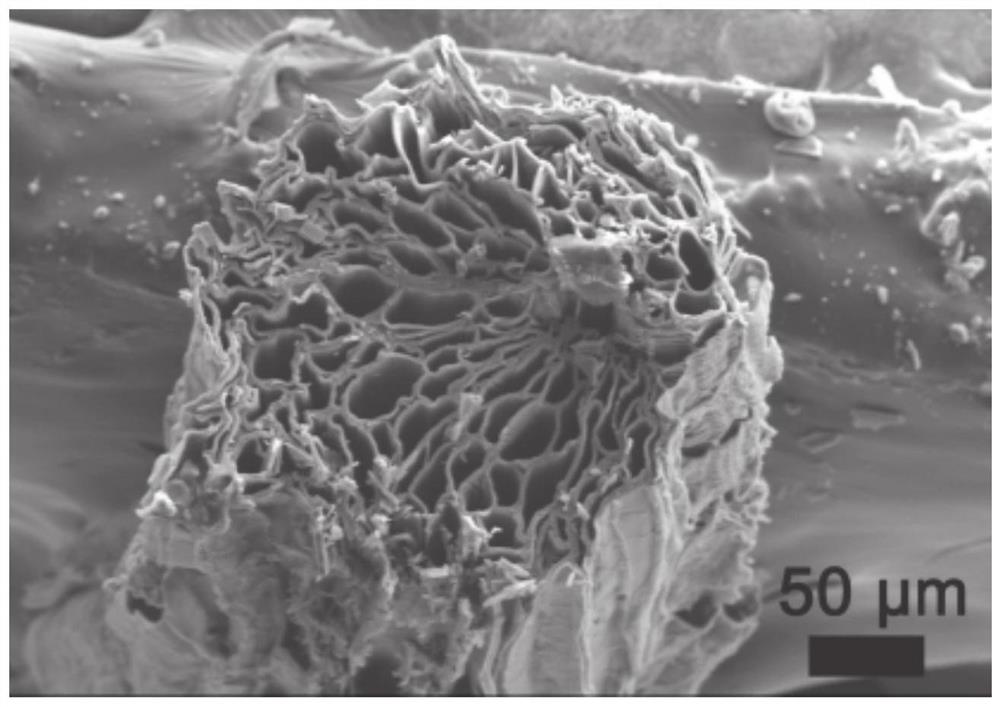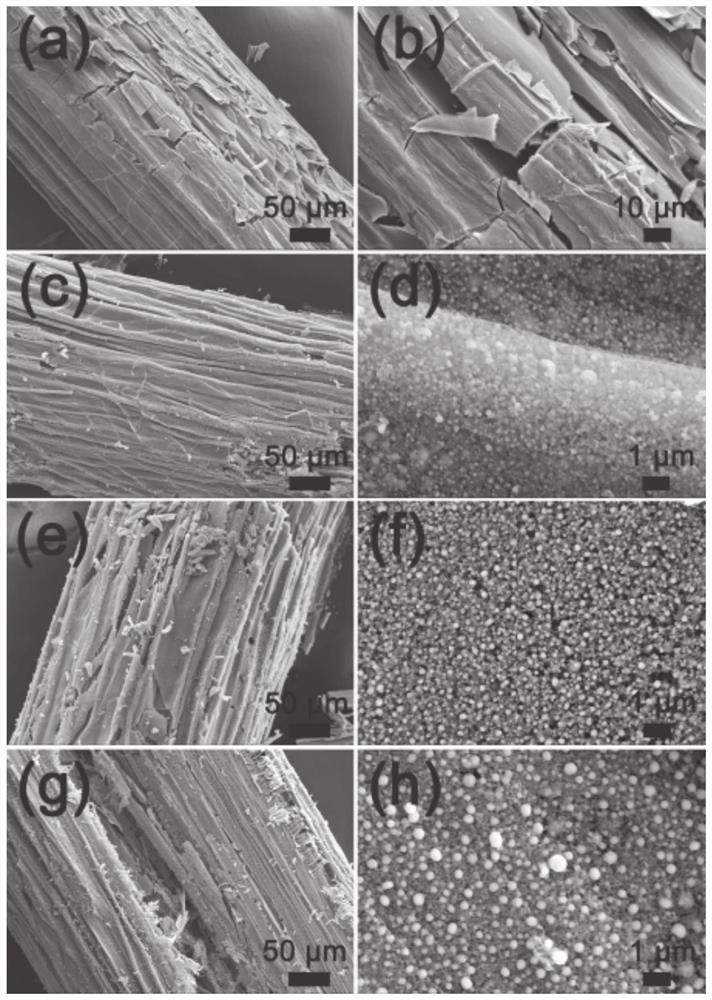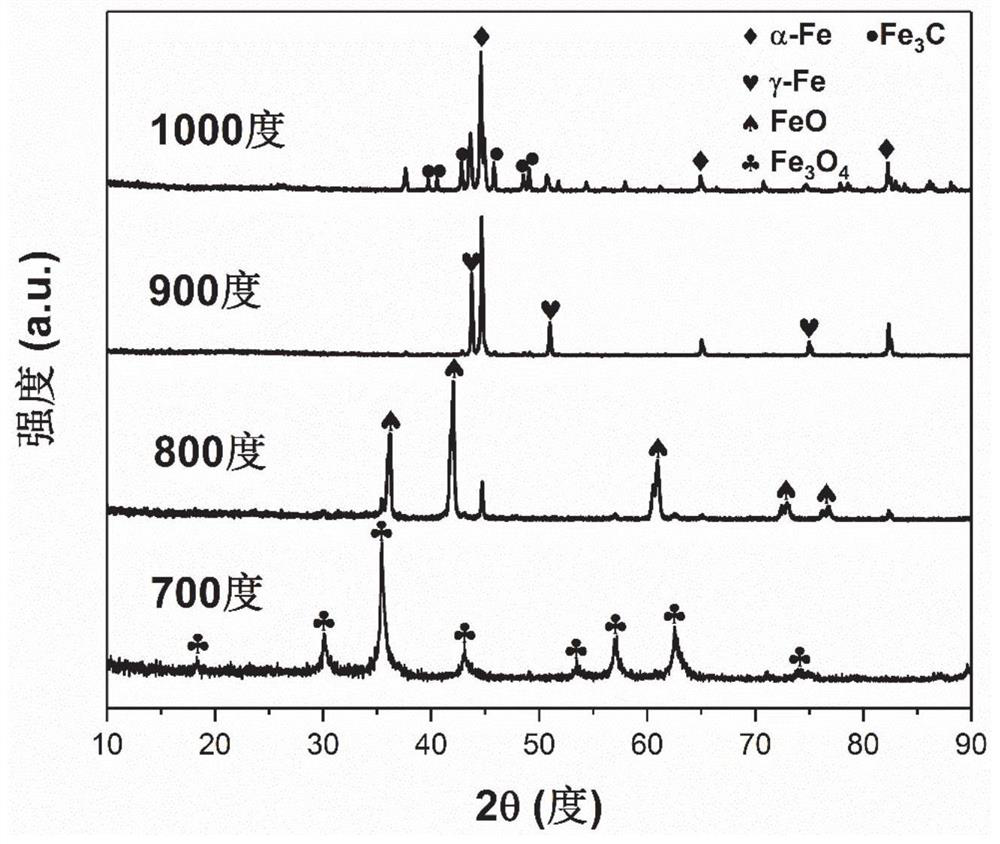Carbon-based porous composite wave-absorbing agent based on natural loofah sponge and preparation method of carbon-based porous composite wave-absorbing agent
A wave absorbing agent and natural silk technology, applied in the field of wave absorbing materials, can solve the problems of unfavorable economy and environmental protection, cumbersome experimental process, prolonging the experimental period, etc., and achieve the effects of easy structural integrity, simple process, and simple processing process.
- Summary
- Abstract
- Description
- Claims
- Application Information
AI Technical Summary
Problems solved by technology
Method used
Image
Examples
Embodiment 1
[0049] Step 1: Soak loofah in 0.8mol / L Fe(NO 3 ) 3 aqueous solution and magnetically stirred for 3 h.
[0050] Appropriate process in this step can make loofah fully and Fe(NO 3 ) 3 Mixing, so that Fe ions are evenly distributed outside the loofah fiber and inside the porous pipe.
[0051] Step 2: Take out the fully soaked loofah and put it in an oven to dry at 100°C for 12 hours.
[0052] Step 3: Put the dried loofah into a tube furnace, raise the temperature to 1000° C. under nitrogen atmosphere and keep it warm for 1.5 hours. After the furnace temperature is cooled to room temperature, the sample is taken out, and the obtained sample is the carbon-based porous absorbing material. The SEM images of the samples are shown in figure 2 Medium (g,h), absorbing performance see Figure 4 Middle (d).
[0053] figure 1 A cross-sectional view of the above-mentioned carbon-based multi-level porous absorbing material is shown.
Embodiment 2
[0055] Step 1: soak the loofah in 1.0mol / L FeCl 3 aqueous solution and magnetically stirred for 5 h.
[0056] Appropriate process in this step can make loofah fully and FeCl 3 Mixing, so that Fe ions are evenly distributed outside the loofah fiber and inside the porous pipe.
[0057] Step 2: Take out the fully soaked loofah and put it into an oven to dry at 90°C for 15 hours.
[0058] Step 3: put the dried loofah into a tube furnace, raise the temperature to 900° C. under a nitrogen atmosphere and keep it warm for 2.0 hours. After the furnace temperature is cooled to room temperature, the sample is taken out, and the obtained sample is the carbon-based porous absorbing material. The SEM images of the samples are shown in figure 2 In (e,f), the absorbing performance see Figure 4 Middle (c).
Embodiment 3
[0060] Step 1: Soak the loofah in 0.8 mol / L ferric sulfate aqueous solution and magnetically stir for 7 hours.
[0061] An appropriate process in this step can fully mix the loofah with ferric sulfate, so that Fe ions are evenly distributed outside the loofah fiber and inside the porous pipe.
[0062] Step 2: Take out the fully soaked loofah and put it in an oven to dry at 80°C for 24 hours.
[0063] Step 3: Put the dried loofah into a tube furnace, raise the temperature to 800° C. under a nitrogen atmosphere and keep it warm for 2.5 hours. After the furnace temperature is cooled to room temperature, the sample is taken out, and the obtained sample is the carbon-based porous absorbing material. The SEM images of the samples are shown in figure 2 In (c,d), the absorbing performance see Figure 4 Middle (b).
PUM
 Login to View More
Login to View More Abstract
Description
Claims
Application Information
 Login to View More
Login to View More - R&D
- Intellectual Property
- Life Sciences
- Materials
- Tech Scout
- Unparalleled Data Quality
- Higher Quality Content
- 60% Fewer Hallucinations
Browse by: Latest US Patents, China's latest patents, Technical Efficacy Thesaurus, Application Domain, Technology Topic, Popular Technical Reports.
© 2025 PatSnap. All rights reserved.Legal|Privacy policy|Modern Slavery Act Transparency Statement|Sitemap|About US| Contact US: help@patsnap.com



